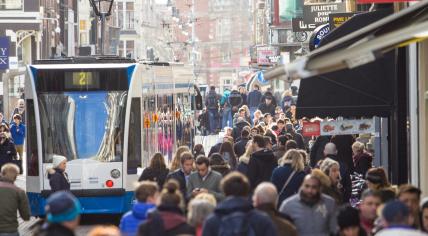
Ethnically diverse immigrants often live in Randstad, Europeans in border areas
Netherlands residents from outside Europe relatively often live in the Randstad - immigrants often in the city, and the second generation who were born in the Netherlands most often just outside the big cities. Most immigrants of European origin live in the border regions in the south of the Netherlands, Statistics Netherlands (CBS) reported on Wednesday.
Of the 17.8 million Netherlands residents on 1 January 2023, 16 percent (2.8 million) were not born in the Netherlands. Almost two-thirds of this group have a non-European origin. The Netherlands also has 2.1 million residents with at least one parent not born in the Netherlands. Among this second generation, over 70 percent have a non-European origin.
Ethnically diverse immigrants are strongly represented in municipalities in the Randstad. The share is the largest in Amstelveen, where over a quarter of residents have roots outside Europe. In Amsterdam and The Hague, that is just under a quarter. Outside the Randstad, Eindhoven has the most ethnically diverse immigrants at 19 percent. The Eindhoven Brainport attracts many knowledge migrants. On average, about 10 percent of a municipality’s residents are immigrants with non-European origins.
Second-generation ethnically diverse immigrants - people born in the Netherlands to parents who moved here from outside Europe - are also mainly located in the Randstad but more often in municipalities just outside the large cities. Almere, Lelystad, Zaanstad, Schiedam, and Zoetermeer are popular hometowns for this group. Rotterdam has the highest percentage of second-generation ethnically diverse immigrants at 20 percent. On average, 8 percent of a Dutch municipality’s residents belong to this population group.
The share of ethnically diverse Netherlands residents (immigrants and second generation) is largest in Rotterdam (43 percent), followed by Amsterdam and The Hague. The share in this group is the smallest in Tubbergen (2.5 percent), followed by Actkarspelen and Dinkelland.
European immigrants tend to live outside the Randstad, especially in the border regions. In Vaals, 36 percent of residents are European immigrants. Zeeland and West Brabant also have relatively high shares. “This mainly concerns people born in Germany and Belgium,” CBS said. Among the larger municipalities, the group of European immigrants is largest in Maastricht (14 percent), The Hague, and Amsterdam (both 13 percent). Nationally, an average of 6 percent of a municipality’s residents are European immigrants.
Second-generation European immigrants are also most concentrated in the southern border municipalities - 12 percent in Baarle-Nassau and 11 percent each in Vaals and Kerkrade. “These are mainly people whose parents were born in Belgium or Germany.”
The total share of Netherlands residents of other European origin is the largest in Vaals (47 percent), Sluis, and Hulst. This group is least strongly represented in Urk (2 percent), followed by Dantumadiel and Achtkarspelen.
